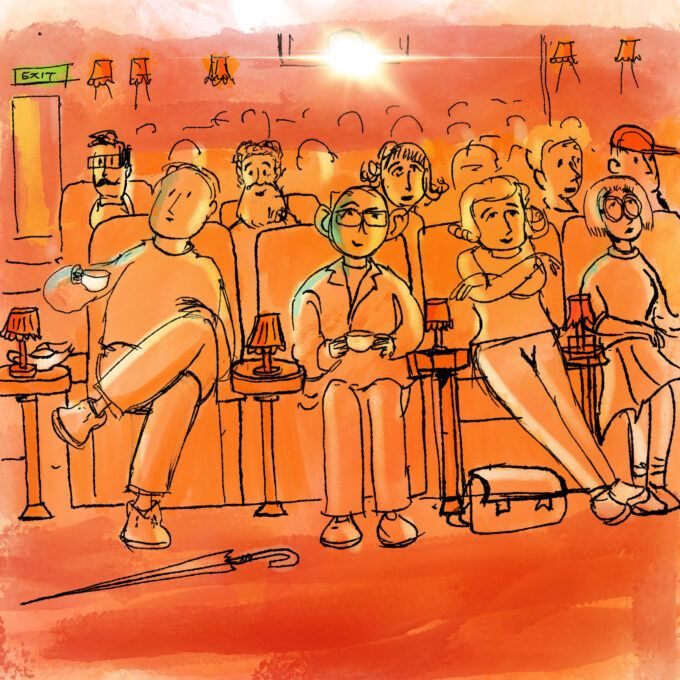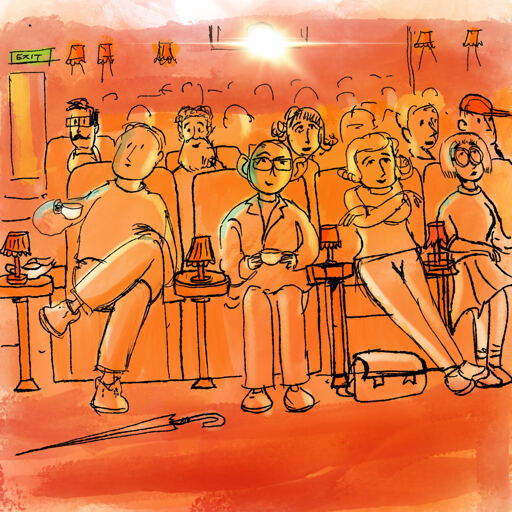
Illustration by Paul Donnellon.
Paul Donnellon, a BAFTA-nominated animator and director, invited me to two private feature film screenings in London’s Soho last week. He is the only man I know who can make every tropical fish in a giant fish-tank hot-swim it away from him the moment he enters a room. Give him a welcome mat, and his feet will have it in shreds within seconds. In truth, he’s a brilliant title designer for Universal, Fox, Warner and HBO, most recently Ethan Coen and Tricia Cooke’s neo-noir Honey Don’t with Margaret Qualley and Aubrey Plaza.
Being back in Soho brought to mind for me years of weekly screenings, when my children were young and I was mistaken for an expert in digital post-production. I often arranged previews of still to be finished films, typically in small dark rooms such as Mr Young’s Preview Theatre, now The Soho Screening Rooms. People still smoked back then. I remember the sound of the projector and cigarette smoke rising above heads, creating this endlessly appetising noirish atmosphere.
Godard’s maxim that “cinema is truth twenty-four times a second” still resonates: screenings in Soho embodied this paradoxical intimacy. That was exactly what it felt like in those half-lit rooms—truth refracted but sharper than daylight. The darkness of an auditorium was a peculiar privacy, shared yet personal. Sitting there, you are alone with your thoughts even as you breathe with strangers beside you.
I love that shift—from the racket of Wardour Street, couriers dodging taxis, pubs spilling conversations onto the pavement, into the padded quiet of a basement room, where the only sound now is the air conditioning before the film begins. It was like stepping into a chapel, a secular devotion, where the liturgy was once celluloid. Godard again: “Cinema is not the station. Cinema is the train.” You feel it the moment the reel moves, or today the digital copy plays, carrying you before you realise you’ve left.
I remember one such screening of Michael Winterbottom’s Code 46. I’d seen it many times already and never tired of Melissa Parmenter’s guide-track piano. At that particular screening, I did not go in—I waited outside.
An unfinished film always felt like a patient under anaesthetic—vulnerable to the wrong incision, yet leaving a record of its making. To invite strangers into that state was an act of trust. A missing scene, a temp track, even an unfixed colour grade—each made the work breathe differently, more ghost than flesh but somehow closer to its heart. Rivette once said, “Every film is a documentary of its own making.” That was never truer than when screening something still raw.
Just then, as I waited outside, came news that Dr Kelly had been found dead in an Oxfordshire wood—still one of the eerier milestones of modern Britain. It was a reminder that cinema never exists in a vacuum: world events pressed in. I told two executives afterwards about Kelly; they walked back with me with pallid faces. A linchpin moment in the WMD saga.
I’ve sat in glossy LA studio lots, where valet-parked cars gleamed more brightly than the reels inside. Soho was always different. Hollywood screenings felt like desperate peeks at profits. Soho’s rooms for me were about cinema itself, the fragile heartbeat of a film not yet alive.
The first film we saw last week—Paul was a BAFTA juror—was pure bliss: Nouvelle Vague directed by Richard Linklater. An early morning screening felt oddly perfect, with seated eagle-eyed cineastes pouring tea by tiny lampshades. It felt like being summoned at dawn for something sacred.
Nouvelle Vague is a lyrical black-and-white take on the making of Breathless, rendering French cinema’s major figures at the time in vivid, humane strokes—never caricatured, always affectionate, weirdly thorough. In that room it felt like a love-in for one of cinema’s defining moments. Rohmer once observed, “A director makes only one movie. Then he breaks it into pieces and makes it again.” Linklater’s film seemed to reassemble Godard’s explosion, reshaping it into homage and new birth.
I was really struck by how rare this communion has become. Outside, algorithms flatten cinema into “content.” True cinema—eccentric, lilting, awkwardly human—seems to be gasping under this weight. But in that room, it felt immortal.
I tried to explain this to a young filmmaker, Cole Pemberton, at our local supermarket. I wished I’d told filmmaker Jerusha West about Nouvelle Vague when I ran into her the next day at Bar Italia. Conversations with emerging directors always confirm that these fleeting Soho moments still matter—not only as memory but as inspiration. The future of such talents can hang on such rooms. Nouvelle Vague deserves everyone’s attention.
The second film, screened at a later time, was Vie privée (A Private Life) by Rebecca Zlotowski, starring Jodie Foster and Daniel Auteuil. This was in the old Mr Young’s building, where more than a decade earlier I put on a screening of my own, at which Richard Dawkins attended. Midway through, I checked up on the famed atheist—but he had fallen asleep. Even distraction—Dawkins asleep—reminded me that cinema’s power lies not in universal absorption but in the traces it leaves behind.
Jodie Foster was playing a troubled expat psychiatrist, Lilian Steiner. She was brilliant, as always. I thought: two Americans in two days working in French. (It was Foster’s first use of French since Jean-Pierre Jeunet’s A Very Long Engagement.) And whatever happened to Woody Allen’s French-language movie Coup de Chance?
As cinematographer George Lechaptois’s poetic use of light in the film deliberately concealed a series of underlying moments of farce, I was thinking how film always leaves a trace—a record not just of light, but of time, breath.
Rohmer said his films were documents, but perhaps all cinema is—documents of what we once felt, where we once sat, who we once were. Maybe that is why all those Soho screenings still matter to me: my own record, flickering, unfinished, but alive. The most recent now shared with Paul Donnellon.
The post Smoke and Light in Soho appeared first on CounterPunch.org.
From CounterPunch.org via this RSS feed


